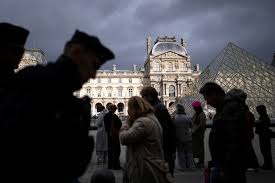Two former delivery drivers suspected of carrying out the heist of France’s crown jewels from the Louvre museum have “partially confessed” to the crime, although police have yet to recover the items, prosecutors said Wednesday.
One suspect was arrested trying to board an aircraft to Algeria on Saturday night with a one-way ticket, and a second man was arrested close to his home, Paris Prosecutor Laure Beccuau told reporters at a news conference.
A major police operation to recover the jewels, worth an estimated $102 million, was still underway 10 days on from the heist, after four thieves used a furniture elevator truck to break into the Galerie d’Apollon and drilled into display cases before they escaped on scooters.
She said the men had “partially” admitted their involvement, with DNA evidence linking them to the crime.
The first suspect is an Algerian national, 34, who was unemployed at the time of his arrest but had previously worked as a delivery driver. The second suspect, 39, is a taxi driver and a former delivery driver. Both were known to the police for past offenses, she said.
Beccuau said investigations to find two further thieves who are still at large continue.
“There is no evidence the thieves benefited from insider help,” she said.
“The jewels have not yet been returned to our possession,” Beccuau said. “I do remain hopeful they will be found and return to the Louvre and the French nation.”
French police acknowledged major gaps in the Louvre’s security Wednesday — turning this month’s shocking daylight theft into a national reckoning over how France protects its treasures.
Paris Police Chief Patrice Faure told senators that aging systems and slow fixes left weak seams in the world’s most-visited museum.
“A technological step has not been taken,” he said, noting parts of the video network are even still analog, producing lower-quality images that are slow to share in real time.
A long-promised revamp — a $93 million project requiring roughly 60 kilometers (37 miles) of new cabling — “will not be finished before 2029-2030,” he said.
Faure also disclosed that the Louvre’s authorization to operate its security cameras quietly expired in July and was not renewed — a paperwork lapse that some see as a symbol of broader negligence after thieves forced a window to the Apollo Gallery, cut into cases with power tools and fled with eight pieces of the French crown jewels within minutes while tourists were inside.
“Officers arrived extremely fast,” Faure said, but he added that the lag occurred earlier in the chain — from first detection to museum security to the emergency line to police command.
Faure and his team said the first alert to police came not from the Louvre’s alarms but from a cyclist outside who dialed the emergency line after having seen helmeted men with a basket lift.
The Louvre values the eight stolen pieces at about $102 million.
The theft has also exposed an insurance blind spot: Officials say the jewels were not privately insured. The French state self-insures its national museums, because premiums for covering priceless heritage are astronomically high — meaning the Louvre will receive no payout for the loss. The financial blow, like the cultural wound, is total.
Faure pushed back against quick fixes. He rejected calls for a permanent police post inside the palace-museum, warning it would set an unworkable precedent and do little against fast, mobile crews. “I am firmly opposed,” he said. “The issue is not a guard at a door; it is speeding the chain of alert.”
He urged lawmakers to authorize tools currently off-limits: artificial intelligence-based anomaly detection and object tracking (not facial recognition) to flag suspicious movements and follow scooters or gear across city cameras in real time.
The Oct. 19 heist was swift and simple. In the morning rush, thieves reached the jewel gallery near streetside windows, cut through reinforced cases and vanished in minutes. Former bank robber David Desclos told The Associated Press that the operation was textbook and that vulnerabilities were glaringly obvious in the layout of the gallery.
—NBC


